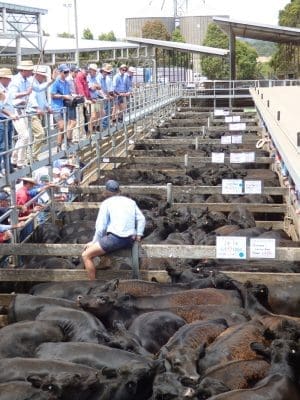 Chris Howie from Agri Careers and Consultancy offers his perspective on southern livestock market trends, drawing from both his own observations and from a wide contact network of producers, agents, processors, industry associates and leaders developed during his extensive career as a livestock agent and former Elders national livestock manager.
Chris Howie from Agri Careers and Consultancy offers his perspective on southern livestock market trends, drawing from both his own observations and from a wide contact network of producers, agents, processors, industry associates and leaders developed during his extensive career as a livestock agent and former Elders national livestock manager.
Cattle – price reset
The cattle market reset seems to have come as a surprise to many considering the continued commentary around demand for 90CL grinding beef and the Chinese export market.
Without digging too deeply I will suggest the correction was for the following reasons.
The Christmas/New Year period lands squarely in the middle of both weeks.
This in turn saw the processors working hard to secure their requirements in advance whether through forward contracts or additional supply within the feedlot system.
With supply set for most works leading into the last 15 days before Christmas the spot market is exposed to reduced demand, hence the reduction in price.
Speaking to several areas that have feed most producers are prepared to wait until after Christmas before moving numbers of trade cattle.
This approach can be double edged as it moves supply back and maintains pricing pressure into January with increased supply.
Southern weaner sales
Weaners sales are the next stage of the southern sale cycle with the large sales ready to fire immediately after the festive break.
 Speaking to agents at Casterton, Hamilton and Mt Gambier the calves look as though they will carry plenty of weight.
Speaking to agents at Casterton, Hamilton and Mt Gambier the calves look as though they will carry plenty of weight.
Weaning protocols – especially this year will pay dividends for calves above 300kg. Do yourself a favour and get your weaning plan mapped out now, not five days before you truck them.
There are very good programs available that can be sourced through Livestock Production Advisors. What do you need – good hay, vaccinations for BRD etc, yards set up with hay at one end and good clean water at the other.
When done properly calves will not lose weight and because properly socialised create a good buyer experience also. Feeders and backgrounders will be looking for young cattle that can go directly onto feed or pasture without checking daily weight gains.
It is important to remember that after the mountain calf sales in March the focus for supply heads towards northern NSW in April/May.
The impact of the drought will see supply numbers drastically impacted in these areas with many cows and calves already sold. It will also see the calves significantly lighter in most cases than other years as well.
The $ up side on light heifers purchased earlier in the year is really paying dividends at present with some fantastic sale results and very tidy trading margins obtained.
One very experienced grazier indicated $900 per head and he has now cleared his inventory and waiting till after Christmas to look for opportunity aligned to repeat sellers.
I dropped into Wodonga store sale on Thursday and saw value in the cow and calf offering at $1250-$1500 on four – six year angus cows with calves at foot.
The prime sale drop last week can provide short term opportunity for cow and calf units as many value on what the cow is worth today not the production value of the cow and sale calf in winter with short supply.
Sam Bartlett from the channel country at Quilpie gave me a call. Sam said: “Currently the big properties out west are doing their last musters. Bullocks and feeders after a good season on the big river systems are presenting very well. Many still have feed in these systems and it is holding up well from the floods in March/April 2019. This has allowed stations to hold back cattle and putting them in a good position for 2020 targeting sale with weight in cattle.
Sheep and lambs
The sheep, lamb and goat space is bouncing along nicely.
Lambs from Victoria and SE of SA are yielding well with a considerable number being trucked to Northern NSW for slaughter as well as all of the southern works. In turn trucks returning are able to provide back loads for purchased livestock helping with the freight component. The sub 30kg store lamb price has definitely eased with many looking for extra weight. At the start of November $4 / kg liveweight was common but it now seems to be sitting at $3.60 – $3.70 per kg. A+ has had a significant number of these lambs offered over the past 2 weeks. I see value in these lambs at present and would suggest securing as many as you can. Get a feed test done on your hay and grain stubbles. Have a nutritionist look at the test and get some advice on what supplementary feeding program will assist continue weight gain for these little fellas. The up side is you have purchased these lambs at the right money. If you aim at 35 kg liveweight you have several strings in your bow, use them to eat summer weeds, put them into feedlot, sell them into feedlot, sell them into a light lamb order or run them on and target end user contracts.
Kevin Thompson Elders Wycheproof agrees and is of the same opinion lambs are buyable at present. However, “this may not last for much longer with many still busy harvesting and agents doing most of the sourcing. The store supply of lambs may start to decline quite quickly. Last Fridays Wycheproof sale remained positive with 1st x 1.5 ewes topping at $370 and 1st x ewe lambs up to $325. Merinos maintained values with Ewe and white Suffolk lamb unit making $360.” Kevin said “the value was still there but the auctioneers needed to work hard to get to the rate. The big wind 2 weeks ago has left a considerable amount of grain on the ground from barley crops also.” Make sure you are mindful of the amount of loose grain on ground when introducing lambs to a stubble.
Grain pricing should provide some opportunities for those looking to feed lambs into the winter supply period. As always do the numbers before launching into a program so you understand all of the drivers, costs and margin. The animal nutrition component is very important as no one wants to “cook” a lambs by getting the ration wrong.
The goat market is holding relatively steady with supply short on back of season. One thing we do know about goats is when there is feed around goats are only one step behind rabbits when it comes to breeding quickly. Price ranges under 40Kg $9.40, over 40kg $7.10.
Wool
Speaking to Brent Squires, Australian Wool Network and gained some insights outside of a normal market report. Brent outlined we only have 2 sales left then a 3 week break so putting your available wool on Wooltrade may provide price upside opportunity. The market is relatively subdued with the main driver being the extended period of high prices forcing end users over the past 18 months to investigate alternatives. As alternatives are introduced the demand picture has soften. Natural / renewable is still in vogue but new technologies are creating new fibre. Wood pulp is one that has appeared using similar tech to synthetics to create a fibre that can be blended. The world economic slow down also puts pressure on demand. China’s growth numbers at a high of 15% are now sub 8% reducing internal consumption. Positive territory is the supply shortage; however, this tends to create a volatile buy then withdraw cycle which is hard to predict. There is still a significant GFC hang over which means any variance sees a significant over correction just in case. Normally 3 indicators aligning drive price lift for wool – we have a supply shortage so if we can have a cold winter in the Northern hemisphere and reduce foreign exchange / tariff impact the potential for some form of rally does exist. However, this is a bit like waiting for rain in Australia – when will it happen.
Industry training update
Last week saw the first course for the Certificate 4 in Agriculture – Service provider and supply chain run at the Wodonga TAFE (RTO) 3097.
After 12 months of planning it has gone off very well with feedback surveys indicating it has helped those involved form a better transactional understanding within their businesses.
Various agencies and wool brokers sent young and new staff along to learn fundamentals of the livestock, wool, finance, stud and supply chain relationships. Attendees came from Wudinna, Geelong, Hamilton, Swan Hill, Ballarat, Corryong, Wagga, Temora, Barossa Valley, Yarrawonga, Roma and New Zealand. Guest speakers included Richard Apps – MLA, Stud stock – Marc Greening – Injemira Herefords, Brent Squires, AWN Wool & Sheep Specialist/Risk Management as well as livestock productivity experts.
The course started on Sunday pm and concluded at Thursday lunch time.
The insight and understanding provided by the speakers really highlighted the opportunity new entrants to this area of agriculture have to develop unique skill sets and point of difference to deliver real benefits to producers.
Montanna Ross from Riverina Livestock Agents, Wagga: “it lets you think about what you do in a different way. Some of the ideas would fit very well with what our business is doing and allows us as younger staff the opportunity to add value as we learn”
Simone Dand, Wodonga TAFE resource developer said: “Watching the change in understanding and group dynamics over the four days becomes very apparent by the end of the course. The participants level of conversation and individual understanding about structuring and conducting business, planning and engagement evolves very quickly when provided direction.”
“We are continually looking at improving delivery and debrief with trainers and the attendees. The 1st group will return in May and share the week with a new intake allowing the creation of a larger networking opportunity and some cross pollination. As the training gains scale, we are looking for Service providers who maybe interested in delivering some content in the future”.
Future course dates are logged in 2020 for February, May, August and September with maximum group size of 15 to ensure best delivery outcomes.
Opportunities
Lambs under 30kg
Cow and calf units
Half wool merinos to shear in March
250kg calves to put out and resell in May/June
Risks
Vaccinate your sheep for Pulpy Kidney (especially rams) if they are heading into a stubble with grain on ground
Do homework on buying droughted livestock – sand and sticks in guts
Get your pasture/stubbles feed tested to set up for joining/trading program with all the information
